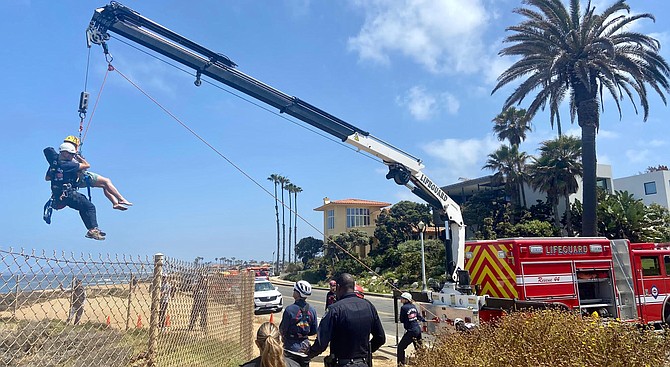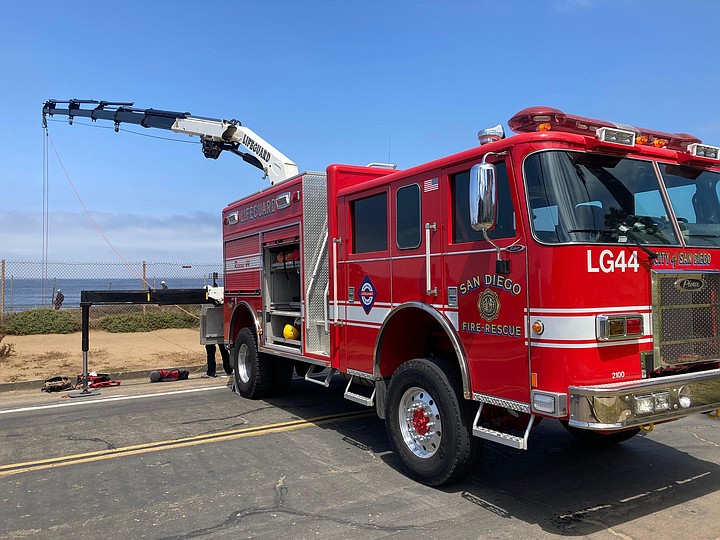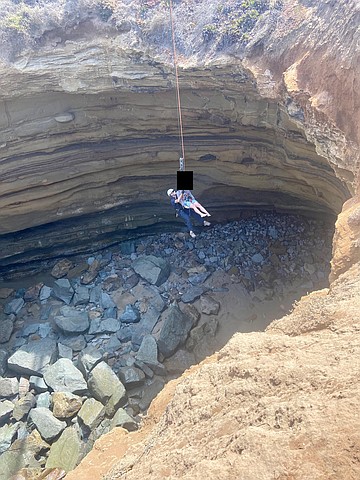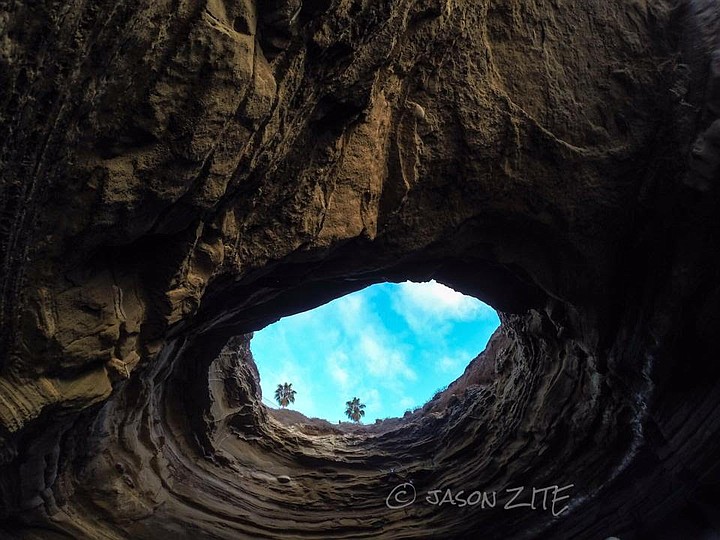 Facebook
Facebook
 X
X
 Instagram
Instagram
 TikTok
TikTok
 Youtube
Youtube

On May 18, a photographer was stuck inside the notorious Sink Hole below Sunset Cliffs in Ocean Beach.
The unidentified man wearing a long sleeve grey shirt, green shorts, and a camera equipment bag entered the ocean cave during low tide — as that's the safest time to get into the open ceiling cave. At 7:13 am that Wednesday, the tides were at −1.67 feet – its lowest of the day.

He went inside "to photograph the tide pools," explained a 911 VIDEO NEWS reporter, one of the first on the scene. "He didn't realize that the tide was rising, and he became trapped." Someone called in about the stranded photographer before 10:30 am that morning, and "a lifeguard was sent in with a Jet Ski, but the male (photographer) did not want to go into the water for fear of his camera gear getting damaged," continued the 911 news reporter."
T.P. saw the Jet Ski footage on YouTube: "How is anyone allowed to dictate how they want to be rescued, especially when it is due to their ignorant, negligent actions?!"
Fire and rescue deployed their Rescue 44 cliff rescue truck to Sunset Cliffs Boulevard and Monaco Street, where the nature photographer parked his vehicle. Then, the Rescue 44 truck driver parked across the main boulevard blocking traffic with its back end facing the Sink Hole that's fenced off. As a result, traffic was re-routed on both ends. Over a dozen neighbors and a dog gathered around the fence to watch the cliff rescue operation. The cliff rescue team is a special unit of the San Diego Fire-Rescue Department.

The cliff-rescue specialist was strapped in and connected to two cables linked to the crane custom mounted onto the rear of the Rescue 44 truck built by Pierce. The lifeguard was then hoisted above the 7-8 foot fence surrounding the cave's massive open ceiling, then slowly dropped down into the cave.
(Since the Instagram photograph and video social media platform launched in 2010, and drones with onboard cameras became more affordable, the Sink Hole became a must-see for YOLO travelers trekking into America's Finest City. One known traveler, Josh, from CaliforniaThroughMyLens.com, said, "To get to the sea cave, you will need to walk to the end of Luscombs Point, where the surfers go down and scramble the roughly hewn steps down to the water.)
Many brave visitors who make it past the slippery wet rocks and into the cave, such as Josh, lose track of time as they are inside the natural cave and the tide outside rises back up. That Wednesday, the day of the rescue, the high tide rose to 4.77 feet. Shortly after 10:30 am, a cliff rescue team member was dropped into the cave. The photographer was strapped into the harness with the first responder, and together, they were extricated from the Sink Hole.
Up top, by Sunset Cliffs Boulevard, Lieutenant Brian Clark of the fire-rescue department continued with the 911 news reporter: "It looks like he has some minor abrasions on his knee but other than that, he said he was not injured. He didn't want any other further medical treatment beyond first aid."

Jason Zite, 51, from Temecula, got in the cave in 2014 and snapped photos from inside with his GoPro camera. "It's been there as long as I've known about it — at least 15 years," he said.
In a 1963 Public Works Appropriations report regarding hearings with the then 87th Congress, it reads: "About 20 feet from the edge of the marine cliff at Ocean Beach, Calif., there is a funnel-shaped sink hole 25 feet in diameter on the flat mantled surface between Sunset Cliffs Boulevard and the conglomerate cliff. It opens into the ceiling of a broad, spacious littoral cave about 30 feet below."
While the report is not specific about the sinkhole and if it's the same one the photographer was extracted from this May, it does continue about how sinkholes developed along Sunset Cliffs. "Several small bays in this same area appear to have been formed by the collapse of the entire roof of such a sea cave. During and after heavy rains, rivulets disappear into tiny ponors [chasms] atop this same cliff. This runoff undoubtedly enters joints widened by littoral speleogenetic processes."

Earlier in the morning of the May 18 rescue, at about 6 am, a group of nature hikers was scheduled to meet with Granger Nature, a local company that provides guided tours of the Sunset Cliffs caves. When I reached out to the company via direct message, I did not receive a response before this article went to print. The company's Facebook page states: "These complete tours are moderate to advanced difficulty, more challenging than other tours with higher tides involved, suitable for those that are active hikers and willing to get wet above their knees, possibly above their waist. Message me for details."
A few days before the Sink Hole rescue, SD Fire-Rescue rescued another man who fell into a hole at a construction site downtown. The first responders used a different crane-type contraption.
In March, SDFD posted photos of a downtown rescue where "A man in his mid 20's fell while working at the site. Crews reached him and assessed his injuries. They packaged him up and used the Lyfe Pulley System to extricate him."


On May 18, a photographer was stuck inside the notorious Sink Hole below Sunset Cliffs in Ocean Beach.
The unidentified man wearing a long sleeve grey shirt, green shorts, and a camera equipment bag entered the ocean cave during low tide — as that's the safest time to get into the open ceiling cave. At 7:13 am that Wednesday, the tides were at −1.67 feet – its lowest of the day.

He went inside "to photograph the tide pools," explained a 911 VIDEO NEWS reporter, one of the first on the scene. "He didn't realize that the tide was rising, and he became trapped." Someone called in about the stranded photographer before 10:30 am that morning, and "a lifeguard was sent in with a Jet Ski, but the male (photographer) did not want to go into the water for fear of his camera gear getting damaged," continued the 911 news reporter."
T.P. saw the Jet Ski footage on YouTube: "How is anyone allowed to dictate how they want to be rescued, especially when it is due to their ignorant, negligent actions?!"
Fire and rescue deployed their Rescue 44 cliff rescue truck to Sunset Cliffs Boulevard and Monaco Street, where the nature photographer parked his vehicle. Then, the Rescue 44 truck driver parked across the main boulevard blocking traffic with its back end facing the Sink Hole that's fenced off. As a result, traffic was re-routed on both ends. Over a dozen neighbors and a dog gathered around the fence to watch the cliff rescue operation. The cliff rescue team is a special unit of the San Diego Fire-Rescue Department.

The cliff-rescue specialist was strapped in and connected to two cables linked to the crane custom mounted onto the rear of the Rescue 44 truck built by Pierce. The lifeguard was then hoisted above the 7-8 foot fence surrounding the cave's massive open ceiling, then slowly dropped down into the cave.
(Since the Instagram photograph and video social media platform launched in 2010, and drones with onboard cameras became more affordable, the Sink Hole became a must-see for YOLO travelers trekking into America's Finest City. One known traveler, Josh, from CaliforniaThroughMyLens.com, said, "To get to the sea cave, you will need to walk to the end of Luscombs Point, where the surfers go down and scramble the roughly hewn steps down to the water.)
Many brave visitors who make it past the slippery wet rocks and into the cave, such as Josh, lose track of time as they are inside the natural cave and the tide outside rises back up. That Wednesday, the day of the rescue, the high tide rose to 4.77 feet. Shortly after 10:30 am, a cliff rescue team member was dropped into the cave. The photographer was strapped into the harness with the first responder, and together, they were extricated from the Sink Hole.
Up top, by Sunset Cliffs Boulevard, Lieutenant Brian Clark of the fire-rescue department continued with the 911 news reporter: "It looks like he has some minor abrasions on his knee but other than that, he said he was not injured. He didn't want any other further medical treatment beyond first aid."

Jason Zite, 51, from Temecula, got in the cave in 2014 and snapped photos from inside with his GoPro camera. "It's been there as long as I've known about it — at least 15 years," he said.
In a 1963 Public Works Appropriations report regarding hearings with the then 87th Congress, it reads: "About 20 feet from the edge of the marine cliff at Ocean Beach, Calif., there is a funnel-shaped sink hole 25 feet in diameter on the flat mantled surface between Sunset Cliffs Boulevard and the conglomerate cliff. It opens into the ceiling of a broad, spacious littoral cave about 30 feet below."
While the report is not specific about the sinkhole and if it's the same one the photographer was extracted from this May, it does continue about how sinkholes developed along Sunset Cliffs. "Several small bays in this same area appear to have been formed by the collapse of the entire roof of such a sea cave. During and after heavy rains, rivulets disappear into tiny ponors [chasms] atop this same cliff. This runoff undoubtedly enters joints widened by littoral speleogenetic processes."

Earlier in the morning of the May 18 rescue, at about 6 am, a group of nature hikers was scheduled to meet with Granger Nature, a local company that provides guided tours of the Sunset Cliffs caves. When I reached out to the company via direct message, I did not receive a response before this article went to print. The company's Facebook page states: "These complete tours are moderate to advanced difficulty, more challenging than other tours with higher tides involved, suitable for those that are active hikers and willing to get wet above their knees, possibly above their waist. Message me for details."
A few days before the Sink Hole rescue, SD Fire-Rescue rescued another man who fell into a hole at a construction site downtown. The first responders used a different crane-type contraption.
In March, SDFD posted photos of a downtown rescue where "A man in his mid 20's fell while working at the site. Crews reached him and assessed his injuries. They packaged him up and used the Lyfe Pulley System to extricate him."
Comments